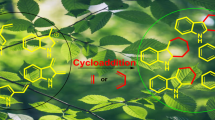Abstract
3,4-Dihydropyrimidin-2(1H)-one/thione analogs of curcumin were synthesized in good yield by a one-pot multi-component cyclocondensation using curcumin, substituted aromatic aldehydes, and urea/thiourea in ethanol and concentrated sulphuric acid. The National Cancer Institute (NCI US) Protocol was followed, and three compounds were evaluated for their anticancer evaluation on leukemia, melanoma, lung, colon, CNS, ovarian, renal, prostate, and breast cancers cell lines. 6-(4-Hydroxy-3-methoxy)-4-(4-methoxyphenyl)-3,4-dihydro-5-[3-(4-hydroxy-3-methoxyphenyl)acryloyl]pyrimidin-2(1H)-one (2) showed maximum activity with mean growth percent of 88.90 and found to be the most sensitive on MDA-MB-231/ATCC (Breast Cancer), PC-3 (Prostate Cancer), SNB-75 (CNS Cancer), RPMI-8226 (Leukemia), MOLT-4 (Leukemia), CCRF-CEM (Leukemia), and HS 578T (Breast Cancer) cell lines with GP of 58.50, 59.60, 60.07, 64.11, 72.84, and 73.39, respectively. The molecular docking studies were also performed to explore the binding mode of the compounds to EGFR tyrosine kinase active site. Compound 4 showed the side-chain hydrogen bond with the residues Asp800 and Thr854, and we also observed the π–cation interactions with methyl group of Lys745. The 4-chlorophenyl part was influenced by the aromatic interactions. The compounds 2 and 7 showed the similar interactions with residues Arg841. Compound 4 showed the hydrogen bonding with residues Met793, Lys745, and Met766, whereas compound 2 showed hydrogen bonding with Met893, Asp800, and Thr854, and compound 7 showed a different hydrogen bonding with the residues Met793, Lys745, Asp800, and Asp855. The aromatic π–π cationic interactions were observed with residue Phe723 in common with the compounds 2, 4, and 7.
Graphical Abstract
3,4-Dihydropyrimidin-2(1H)-one/thione analogs of curcumin were synthesized in good yield by a one-pot multi-component cyclocondensation using curcumin, substituted aromatic aldehydes, and urea/thiourea in ethanol and concentrated sulphuric acid. Among the series of 15, 3,4-dihydropyrimidin-2(H)-one/thione analogs of curcumin, 6-(4-Hydroxy-3-methoxy)-4-(4-methoxyphenyl)-3,4-dihydro-5-[3-(4-hydroxy-3-methoxyphenyl)acryloyl]pyrimidin-2(1H)-one (2) showed maximum anticancer activity on various cancer cell lines, with mean growth percent (GP) of 88.90. The molecular docking studies were also performed to explore the binding mode of the compounds to EGFR tyrosine kinase active site. Binding mode of compound 2 with EGFR tyrosine kinase active site

.





Similar content being viewed by others
References
Ahsan MJ, Khalilullah H, Yasmin S, Jadav SS, Govindasamy J (2013b) Synthesis, characterisation, and in vitro anticancer activity of curcumin analogues bearing pyrazole/pyrimidine ring targeting EGFR tyrosine kinase. BioMed Res Int Article ID 239354, 14 pages, doi:10.1155/2013/239354
Arunkhamkaew S, Athipornchai A, Apiratikul N, Suksamrarn A, Ajavakom V (2013) Novel racemic tetrahydrocurcuminoid dihydropyrimidinone analogues as potent acetylcholinesterase inhibitors. Bioorg Med Chem Lett 23:2880–2882
Blair JA, Rauh D, Kung C, Yun CH, Fan Q, Rode H, Zhang C, Eck MJ, Weiss WA, Shokat KM (2007) Structure-guided development of affinity probes for tyrosine kinases using chemical genetics. Nat Chem Biol 4:229–238
Boyd MR, Paull KD (1995) Some practical considerations and applications of the National Cancer Institute in vitro anticancer drug discovery screen. Drug Dev Res 34:91–109
Feng R, Lu Y, Bowman LL, Qian Y, Castranova V, Ding M (2005) Inhibition of activator protein-1, NF-κB, and MAPKs and induction of phase 2 detoxifying enzyme activity by chlorogenic cid. J Biol Chem 280:27888–27895
Grover GJ, Dzwonczyk S, McMullen DM, Normadin DE, Parham CS, Sleph PG, Moreland S (1995) Pharmacologic profile of the dihydropyrimidine calcium channel blockers SQ 32,547 and SQ 32,926 [correction of SQ 32,946]. J Cardiovasc Pharmacol 26:289–294
http://dtp.nci.nih.gov, (accessed on 22/10/2013)
Jayaprakash GK, Rao LJ, Sakariah KK (2006) Antioxidant activities of curcumin, demethoxycurcumin, and bisdemethoxycurcumin. Food Chem 98:720–724
Kappe CO (1993) 100 Years of the Biginelli dihydropyridine synthesis. Tetrahedron 49:6937–6969
Lal J, Gupta SK, Thavaselvam D, Agarwal DD (2012) Design, synthesis, synergistic antimicrobial activity and cytotoxicity of 4-aryl substituted 3,4-dihydropyrimidinones of curcumin. Bioorg Med Chem Lett 22:2872–2876
Magerramov AM, Kurbanona MM, Abdinbekova RT, Rzaeva IA, Farzaliev VM, Allakhverdiev MA (2006) Synthesis and antioxidative properties of some 3,4-dihydropyrimidin-2(1H)ones (-thiones). Russ J Appl Chem 79:787–790
Mishra S, Karmodiya K, Surolia N, Surolia A (2008) Synthesis and exploration of novel curcumin analogues as anti-malarial agents. Bioorg Med Chem 16:2894–2902
Monks A, Scudiero D, Skehan P, Shoemaker R, Paull K, Vistica D, Hose C, Langley J, Cronise P, Vaigro-Wolff A, Gray-Goodrich M, Campbell H, Mayo J, Boyd M (1991) Feasibility of a high-flux anticancer drug screening using a diverse panel of cultured human tumor cell lines. J Nat Cancer Inst 83:757–766
Shoemaker RH (2006) The NCI60 human tumour cell line anticancer drug screen. Nat Rev Cancer 6:813–823
Yadav IS, Nandekar PP, Shrivastava S, Sangamwar A, Chaudhury A, Agarwal SM (2014) Ensemble docking and molecular dynamics identify knoevenagel curcumin derivatives with potent anti-EGFR activity. Gene 539:82–90
Acknowledgments
The anticancer data were provided by the National Cancer Institute (NC US), Bethesda, MD, USA. We are also grateful for all help provided by Prof. Doug Smallwood and Mr. Mohammed Nayel. The management of Maharishi Arvind College of Pharmacy, Jaipur, Rajasthan, India is acknowledged for providing research facilities.
Author information
Authors and Affiliations
Corresponding author
Rights and permissions
About this article
Cite this article
Sharma, R., Jadav, S.S., Yasmin, S. et al. Simple, efficient, and improved synthesis of Biginelli-type compounds of curcumin as anticancer agents. Med Chem Res 24, 636–644 (2015). https://doi.org/10.1007/s00044-014-1146-2
Received:
Accepted:
Published:
Issue Date:
DOI: https://doi.org/10.1007/s00044-014-1146-2




